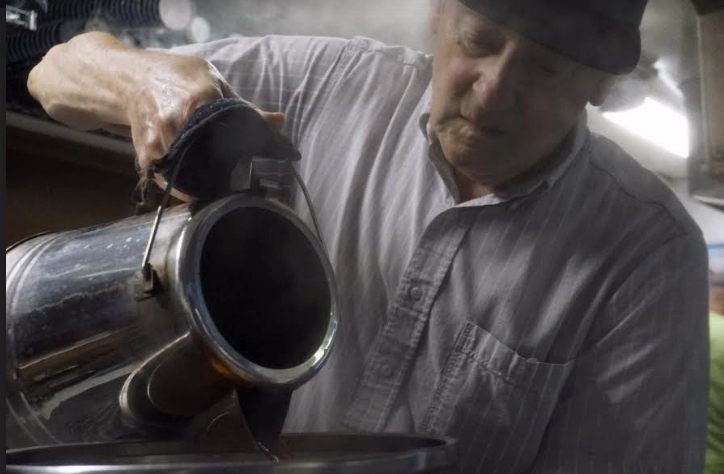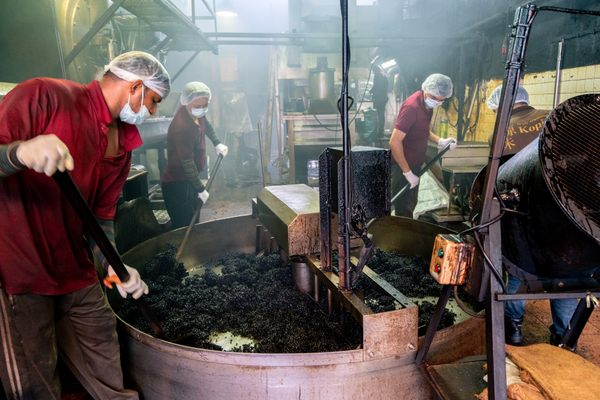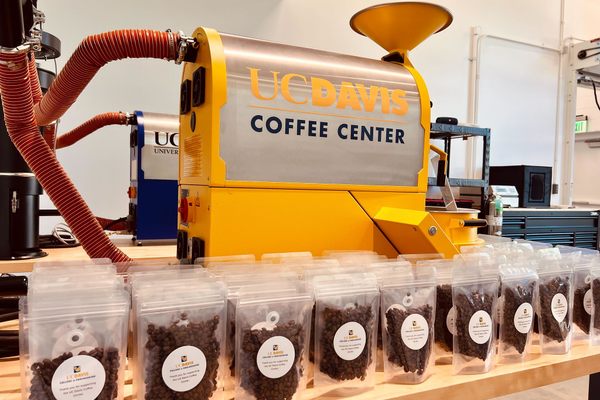The Midwest’s Scandinavian Secret to Eggcellent Coffee
Immigrants from Northern Europe used eggs to make a smooth, tasty brew.
The quest: You want to brew a decent pot of coffee, but it’s the mid-1800s and you just emigrated to a brand new state in the Midwest. There are no percolators or even drip coffee pots available, let alone specialty ground coffee that tastes good no matter how you brew it. So what do you do?
Scandinavian immigrants settling in the Midwest figured out the perfect solution: egg coffee, as in coffee brewed with an egg, shells and all. And their descendants have kept the tradition alive, particularly in Minnesota.
Egg coffee, sometimes called Scandinavian egg coffee, Swedish egg coffee, or even church basement coffee, is such a treat that the Salem Lutheran Church booth selling it each year at the Minnesota State Fair easily goes through 2,000 cups, or about 50 40-cup pots of the brew, by early afternoon on each of the 12 days the fair is open annually. “One very cold day at the fair years ag,o I brewed about 90 pots for breakfast and lunch, and they were equally busy for the evening shift,” recalls Jim Zieba, the resident egg-coffee brewer at the fair for the Salem Lutheran Church diner. He says demand usually drops on hot afternoons.
“Salem was doing egg coffee before I was born, and I just turned 76,” Zieba says. The church, based in North Minneapolis, has offered egg coffee continuously since its church diner opened at the fair in 1946. Zieba’s father made the egg coffee from 1962 through the mid-1980s, and Zieba took the reins after that.

“It’s labor intensive, so most places don’t want to bother,” Zieba says. “But at one time years ago, there were 46 church diners at the fair, and egg coffee was often served at the Lutheran diners.” He also says it was available at most Scandinavian church events years ago, but rarely made now. Even Salem rarely makes it outside of the fair.
So what makes Scandinavian egg coffee so special? While Vietnamese egg coffee is a sweet, strong and dense treat, the Scandinavian version is the complete opposite: a translucent amber in color, and with a smooth, velvety taste. It’s a boiled coffee, made in a stovetop pot. An egg, often (but not always) including the shell, is mashed into ground coffee, and that mixture is dumped into boiling water to brew.
Back a couple hundred years ago, there were no coffee filters, so short of filtering the coffee through a sack or a sock, a basic ground-coffee-and-water brew meant a gritty cup. Scandinavian egg coffee solves this problem with the egg. The protein in the egg clings to the grounds, creating a blobby “raft” that floats when the coffee is ready. Adding cool water at the end sinks the raft and the grounds, resulting in a cleaner pour. This is the same method that chefs use to remove solids in soup for crystal-clear consommé. The optional shells also reduce bitterness.
Scandinavian countries have a long history of adding proteins to coffee to filter out impurities and improve the flavor. Danish coffee expert Asser Christensen says egg coffee is virtually unheard of in Denmark today, but historically, in nearby Norway, “there has been a long-standing tradition of using fish skin and swim bladders for clarification. The Norwegians even have a specific term for it, klareskinn, which literally translates to ‘clearing skin.’”
“It’s interesting to imagine that we could have had ‘Scandinavian fish coffee’ if history had played out differently,” he adds.
Norwegian chemist Martin Lersch notes that klareskinn and eggs, both proteins, would’ve served the same purpose in coffee, as both remove bitterness while making the grounds clump together. He speculates that eggs may have been more available than klareskinn as Scandinavians settled in the Midwest.

Egg coffee was common in the Midwest and beyond through much of the 20th century. The recipe was even in nationally published cookbooks. Fanny Farmer has a recipe in her famous The Boston Cooking-School Cook Book, first published in 1896 and still available today. “Coffee made with an egg has a rich flavor which egg alone can give,” she wrote in the 1901 edition.
In Zieba’s childhood home, egg coffee was a staple. “I’ve known about egg coffee since I was little, as my Swedish grandmother lived with us and made it all the time,” he says. “All my Swedish aunts made egg coffee. My mother made it occasionally until she got her Sunbeam automatic vacuum coffee maker, and that was pretty much the end of egg coffee at our house.”
Jeanne Kistner of Arlington, Minnesota fondly remembers egg coffee. “It was made at home for as long as I can remember, until I got married in 1966.” Her mother taught her to make it, and she continued making it for a while. “My husband loved egg coffee and I did too,” she recalls. “When we first got married, that was the only way I made coffee.” Kistner says her aunts also made egg coffee, and agrees with Zieba’s assessment of why this brewing method isn’t so common anymore. “I think after the percolators and drip coffee pots came out, egg coffee kind of disappeared.”
Few places other than the Minnesota State Fair offer egg coffee on the regular, but there is one restaurant that serves it: Myriel in St. Paul, Minnesota. Its owner, Chef Karyn Tomlinson, says it’s the only coffee they serve.“As far as I know this is a Swedish immigrant/farmer tradition,” Tomlinson says. “My grandmother made egg coffee every day of her life, and my great Aunt Shirley still makes it at 90.”
“It also typically isn’t made very strong,” she adds. “It’s not unusual for people who drink other coffee with cream to drink egg coffee black.”

During the pandemic, Tomlinson created an Instagram cooking series called Karyn’s Quarantine Kitchen. One episode features egg coffee made in her traditional Swedish enamel coffee pot, and brewed without eggshells, as her grandmother made it.
“When I was first brainstorming about a menu for Myriel, I knew that I’d want to have this coffee on the menu,” she says. “It so uniquely represents a certain type of hospitality that was formative for me before I even knew I wanted to be a chef. Perhaps hailing from the Swedish tradition of fika and kokkafe [boiled coffee], there was always a ready kettle on the stove whenever I’d visit family in the Minnesota farming community. It’s that kind of unpretentious, kind hospitality that I want to show my guests today.”
Even if it’s impractical compared to modern coffee-making techniques, egg coffee has survived because of the warmth it evokes. For Jeanne Kistner, discussing egg coffee brought back pleasant memories, and she plans to shop for a coffee pot to make it again. “It will be a treat,” she says.
Egg Coffee, The Salem Lutheran Church Way
Salem Lutheran Church has made egg coffee for the Minnesota State Fair for generations. Jim Zieba shares his recipe.
- Makes 12 cups
Ingredients
- Ground coffee
- One egg
Instructions
-
Add water to a stovetop percolator pot with the filter basket removed. Bring the water to a boil.
-
Whip the egg in a little water, to about the consistency of French toast batter.
-
Place 3 to 4 tablespoons ground coffee in a small bowl, plus just enough of the egg batter to saturate the grounds. Add some of the eggshell if you like and mash it in.
-
Dump the mixture into the boiling water, adjusting the heat to prevent boiling over. Allow it to boil briefly, then remove from heat.
-
Let the grounds settle or pour some cold water on top them to sink them.
- Pour coffee into cups through a small strainer to catch stray grounds, or just pour directly into cups and the stray grounds will settle.
Notes and Tips
To make a church-style 40-cup pot:
Place 2 cups ground coffee in a saucepan. Mash an egg, shell and all, into the grounds. Bring a 40-cup pot full of water to a rolling boil. Reduce heat slightly, then add the grounds mixture.
Adjust heat as needed to keep it from boiling over. After 30 to 60 seconds at a moderate boil, turn off the burner and let the grounds settle. Pour a cup of cold water on the brew to settle the grounds faster.
After this, the coffee may be poured into warming carafes.
Gastro Obscura covers the world’s most wondrous food and drink.
Sign up for our regular newsletter.





























Follow us on Twitter to get the latest on the world's hidden wonders.
Like us on Facebook to get the latest on the world's hidden wonders.
Follow us on Twitter Like us on Facebook